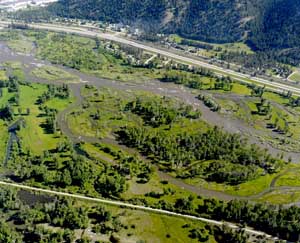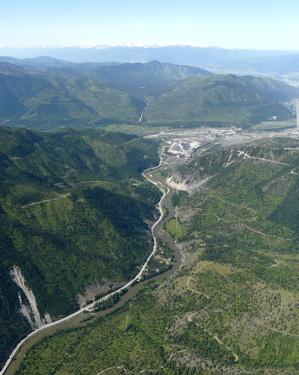 Clark Fork River near Piltzville The Clark Fork and Blackfoot Rivers converge just outside Milltown, Montana, which was once known as Riverside. The two rivers are among the Rocky Mountain headwaters of the Columbia River.
Clark Fork River near Piltzville The Clark Fork and Blackfoot Rivers converge just outside Milltown, Montana, which was once known as Riverside. The two rivers are among the Rocky Mountain headwaters of the Columbia River.
The Clark Fork River originates roughly 120 miles upstream of the confluence near the Warm Springs Ponds. Here, Silver Bow Creek and Warm Springs Creek and other feeder streams merge near Opportunity, Montana. Both the upper Clark Fork and Silver Bow Creek, contaminated with mine wastes, are Superfund sites.
From its origins, the Clark Fork River flows north and west for the next 350 miles to the Lake Pend Oreille, just over the Montana-Idaho border. The Clark Fork along the way gathers tributaries large and small such as the Little Blackfoot, Flint Creek, Rock Creek, the Blackfoot, the Rattlesnake, the Bitterroot and the Flathead Rivers. By the time the Clark Fork enters Lake Pend Oreille, it is Montana's largest river, averaging more than 22,000 cubic feet of water per second.
 Lower Blackfoot River near Bonner The Blackfoot starts on the Continental Divide northeast of Lincoln. From there it flows more than 130 miles to its meeting point with the Clark Fork River. Along the way it picks up numerous tributaries, including the Landers Fork, Nevada Creek, the North Fork of the Blackfoot, the Clearwater and Gold Creek.
Lower Blackfoot River near Bonner The Blackfoot starts on the Continental Divide northeast of Lincoln. From there it flows more than 130 miles to its meeting point with the Clark Fork River. Along the way it picks up numerous tributaries, including the Landers Fork, Nevada Creek, the North Fork of the Blackfoot, the Clearwater and Gold Creek.
Native Missoulian author Norman Maclean described the Blackfoot in his renowned book A River Runs Through It, writing,
“The straight line on the map also suggests [the Blackfoot's] glacial origins; it has no meandering valley, and its few farms are mostly on its southern tributaries which were not ripped up glaciers; instead of opening into a wide flood plain near its mouth, the valley, which cut overnight by a disappearing lake when the great ice dam melted, gets narrower and narrower until the only way a river, an old logging railroad, and an automobile can fit into it is for two of them to take to the mountainsides.”
